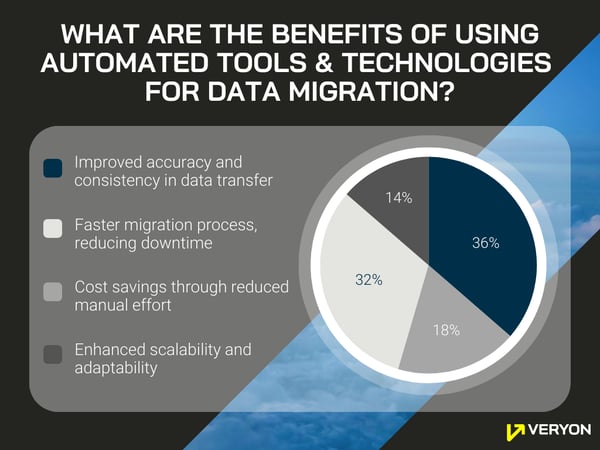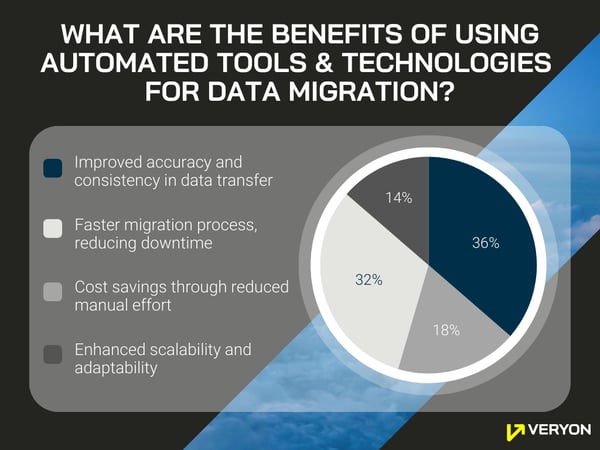Migrating data in aviation maintenance software isn’t just about moving records from one system to another—it’s about ensuring continuity, accuracy, and operational efficiency. Without the right approach, organizations risk carrying over bad data or, worse, losing critical maintenance history. As Peter Mortimer, Veryon Head of Sales & BD (Americas & APAC), pointed out in a recent National Business Aviation Association thought leadership webinar:
A structured data migration plan can prevent these pitfalls. In this blog, we’ll explore best practices, recommended tools, and the importance of departmental collaboration.
Key steps for a smooth data migration
Organize and structure data early
Before migration begins, categorizing and structuring data efficiently can prevent downstream issues. Data should be organized logically based on aircraft components, maintenance logs, and historical records. Kim Watne, Veryon Aviation Data Quality Technical Analyst, shared how proper organization streamlined her migration experience:
Map and standardize data
Understanding how data is structured in the old system versus the new system is critical. Many legacy systems use different terminology, which can create inconsistencies if not addressed. Justin Linscomb, Veryon Director of Data Quality, stressed the importance of data mapping:
By developing a clear mapping strategy, organizations can avoid discrepancies and achieve accurate data translation.
Cleanse and validate data
Migration presents a prime opportunity to clean and standardize data. Removing duplicate entries, correcting inconsistencies, and validating historical records enhances data integrity. Mortimer recommends using this transition as a chance to improve data quality:
Strategic planning and thorough assessment
Effective data migration begins with meticulous planning and a comprehensive assessment of existing data. By setting clear objectives and understanding the structure and dependencies of the data, organizations can mitigate risks and streamline the transition.
- Define migration objectives: Clearly articulate the goals and desired outcomes of the migration project.
- Identify data dependencies: Analyze relationships between different data sets to guarantee smooth migration.
- Data profiling: Analyze data structure, format, and content to understand the source data thoroughly before mapping.
- Data mapping: Create detailed mapping rules to accurately translate data from the old system to the new one.
Rigorous testing and validation
Testing is a crucial phase in the migration process, ensuring data accuracy, consistency, and functionality before full implementation. By conducting controlled test runs, organizations can detect and resolve issues proactively, reducing the likelihood of errors post-migration.
- Test environment: Set up a dedicated testing environment to simulate the migration process and identify potential issues.
- Data migration testing: Conduct thorough testing on data samples to validate data integrity and transformation accuracy.
- Dry runs: Perform full-scale data migration simulations to identify bottlenecks and refine the process.
Leveraging automation for a more efficient migration
Automation plays a major role in streamlining data migration, reducing manual errors, and maintaining accuracy.
Use Excel as a flexible tool
While many modern software solutions include migration utilities, Excel remains a staple. It allows teams to format and cleanse data efficiently. Watne shared her experience:
Automated extraction and mapping
Automation removes the need for manual data interpretation and facilitates structured data conversion. Linscomb explained:
Reducing onboarding time and errors
By automating data extraction and entry, companies can significantly cut down on transition time. Linscomb noted:
Poll results: The key benefits of automated data migration
 To further validate the importance of automation, a group of aviation experts was polled on the key benefits of using automated tools and technologies for data migration.
To further validate the importance of automation, a group of aviation experts was polled on the key benefits of using automated tools and technologies for data migration.
These results highlight the industry’s recognition of accuracy and speed as the top advantages of automation, reinforcing the need for well-integrated tools during migration.
The importance of cross-departmental collaboration
Data migration isn’t just an IT responsibility—it requires input from multiple departments to facilitate seamless integration.
Sequential migration between teams
Teams often migrate data at different paces to avoid workflow disruption. Watne explained how procurement and maintenance worked together during her migration:
Ongoing auditing for accuracy
Frequent audits verify that the data remains accurate post-migration. Watne shared her process:
Communication is key
Data migration requires ongoing dialogue between stakeholders. Linscomb emphasized:
Leveraging real-time data and Veryon Tracking for seamless data migration
Real-time data capabilities play a crucial role in modernizing data migration processes. By integrating tools like Veryon Tracking, organizations can:
- Improve Accuracy: Real-time updates help detect discrepancies and prevent outdated information from being migrated.
- Enhance Visibility: Maintenance teams can track changes instantly, reducing the risk of data loss during transition.
- Increase Efficiency: Automated alerts and tracking features allow organizations to monitor data migration progress and address issues proactively.
Veryon Tracking provides real-time monitoring and validation, ensuring that critical maintenance records are preserved and accessible when transitioning to a new system. Organizations that leverage real-time data integration can significantly reduce risks associated with migration and improve operational efficiency.
Final thoughts
Data migration in aviation maintenance isn’t just a technical task—it’s a business-critical process that impacts efficiency, compliance, and operational reliability. By following best practices, leveraging automation, and fostering interdepartmental collaboration, organizations can achieve a seamless transition and maintain the integrity of their maintenance records.
As Mortimer put it:
Watch the full conversation about data migration.
Take the next step with Veryon Tracking
If you’re looking for a reliable solution to manage your aviation maintenance data efficiently, Veryon Tracking offers a seamless and automated approach to data migration. With industry-leading tools and expert support, we help organizations transition smoothly while maintaining data integrity.
Learn more about how Veryon Tracking can transform your maintenance operations—Contact us today!




